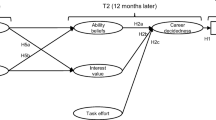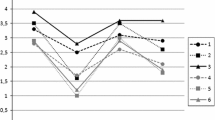Abstract
A strong desire for achievement may be seen asan important component of student motivation to completecollege. This study examined the structuralrelationships among four constructs: (1) motivational factors, (2) student background factors, (3)academic performance, and (4) persistence. Motivationand background factors were examined to determine theirdirect and indirect effects on academic performance and persistence for minorities andnonminorities. The study supported utilization offactors external to the students' college experienceidentified in the retention literature based on Bean's(1980) Student Attrition Model. While it was found thatmotivation failed to impact academic performance foreither racial subgroup, a significant motivationaleffect on persistence was found for minorities but notfor nonminorities in this study. Minority studentswith high levels of motivation tended to persist totheir second year. Policy implications arediscussed.
Similar content being viewed by others
REFERENCES
Allen, D., and Nora, A. (1995). An empirical examination of the construct validity of goal commitment in the persistence process. Research in Higher Education36: 509-533.
Anderson, J. C., and Gerbing, D. W. (1988). Structural equation modeling in practice: A review and recommended two-step approach. Psychological Bulletin103: 411-423.
Arcuri, A., Daly, W., and Mercado, P. (1982). Academic boot camp. In K. V. Lauridgen and C. Myers (eds.), Summer programs for underprepared freshman. New Directions for College Learning Assistancevol. 10, pp. 13-20. San Francisco: Jossey-Bass.
Astin, A. W. (1975). Preventing Students from Dropping Out. San Francisco: Jossey-Bass.
Astin, A. W. (1993). What Matters in College: Four Critical Years Revisited. San Francisco: Jossey-Bass.
Attinasi, L. C. (1989). Getting in: Mexican Americans' perceptions of university attendance and the implications for freshmen year persistence. Journal of Higher Education60: 247-277.
Bean, J. P. (1980). Dropouts and turnover: The synthesis and test of a causal model of student attrition. Research in Higher Education12: 155-187.
Bean, J. P. (1982). Conceptual models of student attrition: How theory can help the institutional researcher. In E. Pascarella (ed.), New Directions for Institutional Research: Studying Student Attrition, vol. 36, pp. 17-33. San Francisco: Jossey-Bass.
Bean, J. P., and Vesper, N. (1990). Qualitative approaches to grounding theory in data: Using LISREL to develop a local model and theory of student attrition. Paper presented at the annual meeting of the American Educational Research Association, Boston, MA.
Bollen, K. A. (1989). Structural Equations with Latent Variables. New York: John Wiley & Sons.
Brower, A. (1992). The ª second halfº of student integration: The effects of life task predominance on student persistence. Journal of Higher Education63: 441-461.
Burrel, R. J., and Cardoza, D. (1988). The relationship of Spanish language background to academic achievement: A comparison of three generations of Mexican-American and Anglo-American high school seniors. In J. R. Garcia, J. C. Rodriguez, and C. Lomas, (eds.), Times of Challenge: Chicanos and Chicanas in American Society. Mexican American Studies Monograph Series No. 6, pp. 69-81. Houston, TX: University of Houston.
Cabrera, A., Stampen, J., and Hansen, W. (1990). Exploring the effects of ability to pay on persistence in college. Review of Higher Education13: 303-336.
Cabrera, A., Nora, A., and Castaneda, M. (1992). The roles of finances in the persistence process: A structural model. Research in Higher Education33: 571-593.
Cabrera, A., Nora, A., and Castaneda, M. (1993). Structural equations modeling test of an integrated model of student retention. Journal of Higher Education64: 123-139.
Cardoza, D. (1991). College attendance and persistence among Hispanic women: An examination of some contributing factors. Sex Roles24: 133-146.
Castaneda, M. B. (1993). Revisiting the factor structure of LBDQ: An application of confirmatory factor analysis. Paper presented at the Annual Meeting of the Academy of Management. Atlanta, GA.
Cope, R., and Hannah, W. (1975). Revolving College Doors: The Causes and Consequences of Dropping Out, Stopping Out and Transferring. New York:: Wiley-Interscience.
Ethier, M. (1997). Male basketball players continue to lag in graduation rates. Chronicle of Higher Education, July 3, p. A39.
Hauser, R. M., and Anderson, D. K. (1991). Post-high school plans and aspirations of black and white high school seniors: 1976-86. Sociology of Education64: 263-277.
Hurtado, S., Carter, D. F., and Spuler, A. (1996). Latino student transition to college. Research in Higher Education37: 135-157.
Joreskog, K. G. (1993). Testing structural equation models. In K. A. Bollen and J. S. Long (eds.), Testing Structural Equation Models, pp. 294-316. Newbury Park, CA: Sage Publications.
Joreskog, K. G., and Sorbom, B. (1988). PRELIS: A Program for Multivariate Data Screening and Data Summarization, 2nd ed. Mooresville, IN: Scientific Software.
Joreskog, K. G., and Sorbom, B. (1993). LISREL 8. Hillsdale, NJ: Lawrence Erlbaum Associates.
Karsenti, T., and Thibert, G. (1994). The influences of gender differences on within-term changes in junior college student motivation. Paper presented at the American Educational Research Association 1994 Annual Meeting, New Orleans, Louisiana.
Kealy, M. J., and Rockel, M. L. (1987). Student perceptions of college quality: The influence of college recruitment policies. The Journal of Higher Education58: 683-703.
Kramer, M. (1993). Lengthening of time-to-degree. Change25: 5-7.
Marsh, H. W., Balla, J. R., and McDonald, R. P. (1988). Goodness-of-fit indexes in confirmatory factor analysis: The effect of sample size. Psychological Bulletin103: 391-410.
Nettles, M. T., Theony, A. R., and Gosman, E. J. (1986). Comparative and predictive analysis of black and white students' college achievement and experiences. Journal of Higher Education57: 289-328.
Noel, L., and Levitz, P. (1993). The RMS Technical Guide, pp. 165-184.
Nora, A. (1987). Determinants of retention among Chicano college students: A structural model. Research in Higher Education26: 31-59.
Nora, A., and Cabrera, A. F. (1993). Examining graduate education through structural modeling. New Directions for Institutional Research, vol. 80, pp. 41-58. San Francisco: Jossey-Bass.
Nora, A., and Cabrera, A. F. (1996). The role of perceptions of prejudice and discrimination on the adjustment of minority students to college. Journal of Higher Education67: 119-148.
Nora, A., and Rendon, L. (1990a). Differences in math and science preparation and participation among community college minority and nonminority students. Community College Review18: 29-39.
Nora, A., and Rendon, L. (1990b). Determinants of predisposition to transfer among community college students: A structural model. Research in Higher Education31: 235-255.
Nora, A., Attinasi, L., and Matonak, A. (1990). Testing qualitative indicators of precollege factors in Tinto' s model of college withdrawal: A community college student population. Review of Higher Education13: 337-356.
Pascarella, E. T., and Terenzini, P. T. (1979). Interaction effects in Spady and Tinto' s conceptual models of college dropout. Sociology of Education52: 197-210.
Pascarella, E. T., and Terenzini, P. T. (1980). Predicting freshman persistence and voluntary dropout decisions from a theoretical model. Journal of Higher Education51: 60-75.
Pascarella, E. T., and Terenzini, P. T. (1983). Predicting voluntary freshman year persistence/ withdrawal behavior in a residential university: A path analytic validation of Tinto' s model. Journal of Educational Psychology75: 215-226.
Pascarella, E. T., and Terenzini, P. T. (1991). How College Affects Students. San Francisco: Jossey-Bass.
Pittman, T. S., and Boggiano, A. K. (1992). Psychological perspectives on motivation and achievement. In A. K. Boggiano and T. S. Pittman (eds.), Achievement and Motivation: A Social-Developmental Perspective, pp. 1-5. London: Cambridge Press.
Porter, O. F. (1990). Undergraduate Completion and Persistence at Four-Year Colleges and Universities. Washington, DC: The National Institute of Independent Colleges and Universities.
Ramist, L. (1981). College Student Attrition and Retention. Princeton, NJ: Educational Testing Service.
Raynor, J. O., and Entin, E. E. (1982). Achievement motivation as a determinant of persistence in contingent and noncontingent paths. In J. O. Raynor, and E. E. Entin (eds.), Motivation, Career Striving, and Aging, p. 83. Washington, DC: Hemisphere Publishing Corporation.
Stage, F. K., and Williams, P. D. (1988). Students' motivation and changes in motivation during the first year of college. Paper presented at the Association for the Study of Higher Education 1988 Annual Meeting, St. Louis, Missouri.
Stoecker, J., Pascarella, E., and Wolfle, L. (1988). Persistence in higher education: A nine year test of a theoretical model. Journal of College Student Development29: 196-209.
Thompson, C. E., and Fretz, B. R. (1991). Predicting the adjustment of black students at predominately white institutions. Journal of Higher Education62: 437-450.
Terenzini, P., and Wright, T. (1987). Students' personal growth during the first two years of college. The Review of Higher Education10: 259-271.
Tierney, W. (1992). An anthropological analysis of student participation in college. Journal of Higher Education63: 603-618.
Tinto, V. (1987a). The principles of effective retention. Paper presented at the Maryland College Personnel Association Fall Conference, Largo, Maryland.
Tinto, V. (1987b). Leaving College: Rethinking the Causes and Cures of Student Attrition. Chicago, IL: The University of Chicago Press.
Tinto, V. (1996). Reconstructing the first year of college. Planning for Higher Education25: 1-6.
Tracey, T. J., and Sedlacek, W. E. (1985). The relationship of noncognitive variables to academic success: a longitudinal comparison by race. Journal of College Student Personnel26: 405-410.
Tracey, T. J., and Sedlacek, W. E. (1987). Prediction of college graduation using noncognitive variables by race. Measurement and Evaluation in Guidance19: 177-184.
White, R. W. (1959). Motivation reconsidered: The concept of competence. Psychological Review66: 297-333.
Rights and permissions
About this article
Cite this article
Allen, D. DESIRE TO FINISH COLLEGE: An Empirical Link Between Motivation and Persistence. Research in Higher Education 40, 461–485 (1999). https://doi.org/10.1023/A:1018740226006
Issue Date:
DOI: https://doi.org/10.1023/A:1018740226006




